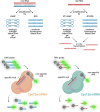A short overview of CRISPR-Cas technology and its application in viral disease control
- PMID: 33830423
- PMCID: PMC8027712
- DOI: 10.1007/s11248-021-00247-w
A short overview of CRISPR-Cas technology and its application in viral disease control
Abstract
Clustered Regularly Interspaced Short Palindromic Repeats (CRISPRs) together with CRISPR-associated (Cas) proteins have catalysed a revolution in genetic engineering. Native CRISPR-Cas systems exist in many bacteria and archaea where they provide an adaptive immune response through sequence-specific degradation of an invading pathogen's genome. This system has been reconfigured for use in genome editing, drug development, gene expression regulation, diagnostics, the prevention and treatment of cancers, and the treatment of genetic and infectious diseases. In recent years, CRISPR-Cas systems have been used in the diagnosis and control of viral diseases, for example, CRISPR-Cas12/13 coupled with new amplification techniques to improve the specificity of sequence-specific fluorescent probe detection. Importantly, CRISPR applications are both sensitive and specific and usually only require commonly available lab equipment. Unlike the canonical Cas9 which is guided to double-stranded DNA sites of interest, Cas13 systems target RNA sequences and thus can be employed in strategies directed against RNA viruses or for transcriptional silencing. Many challenges remain for these approach, including issues with specificity and the requirement for better mammalian delivery systems. In this review, we summarize the applications of CRISPR-Cas systems in controlling mammalian viral infections. Following necessary improvements, it is expected that CRISPR-Cas systems will be used effectively for such applications in the future.
Keywords: CRISPR; Cas13 protein; Detection kit; Viral RNA; Viral disease.
Conflict of interest statement
The authors declare that they have no conflict of interest. The research reported here did not involve experimentation with human participants or animals.
Figures



Similar articles
-
[The application of CRISPR-Cas9 gene editing technology in viral infection diseases].Yi Chuan. 2015 May;37(5):412-8. doi: 10.16288/j.yczz.14-460. Yi Chuan. 2015. PMID: 25998428 Review. Chinese.
-
CRISPR-Cas based genome editing for eradication of human viruses.Prog Mol Biol Transl Sci. 2024;208:43-58. doi: 10.1016/bs.pmbts.2024.07.012. Epub 2024 Aug 17. Prog Mol Biol Transl Sci. 2024. PMID: 39266187 Review.
-
CRISPR-Cas based targeting of host and viral genes as an antiviral strategy.Semin Cell Dev Biol. 2019 Dec;96:53-64. doi: 10.1016/j.semcdb.2019.04.004. Epub 2019 Apr 8. Semin Cell Dev Biol. 2019. PMID: 30953741 Free PMC article. Review.
-
Therapeutic Strategies of Clustered Regularly Interspaced Palindromic Repeats-Cas Systems for Different Viral Infections.Viral Immunol. 2017 Oct;30(8):552-559. doi: 10.1089/vim.2017.0055. Epub 2017 Aug 21. Viral Immunol. 2017. PMID: 28825529 Review.
-
Applications of CRISPR/Cas13-Based RNA Editing in Plants.Cells. 2022 Aug 27;11(17):2665. doi: 10.3390/cells11172665. Cells. 2022. PMID: 36078073 Free PMC article. Review.
Cited by
-
Gene Editing Technologies to Target HBV cccDNA.Viruses. 2022 Nov 28;14(12):2654. doi: 10.3390/v14122654. Viruses. 2022. PMID: 36560658 Free PMC article. Review.
-
CRISPR/Cas9 Ablation of Integrated HIV-1 Accumulates Proviral DNA Circles with Reformed Long Terminal Repeats.J Virol. 2021 Nov 9;95(23):e0135821. doi: 10.1128/JVI.01358-21. Epub 2021 Sep 22. J Virol. 2021. PMID: 34549986 Free PMC article.
-
Concanavalin-A-assisted extraction-free one-pot RPA-CRISPR/Cas12a assay for rapid detection of HPV16.Mikrochim Acta. 2025 May 14;192(6):354. doi: 10.1007/s00604-025-07198-7. Mikrochim Acta. 2025. PMID: 40369306
-
Network for network concept offers new insights into host- SARS-CoV-2 protein interactions and potential novel targets for developing antiviral drugs.Comput Biol Med. 2022 Jul;146:105575. doi: 10.1016/j.compbiomed.2022.105575. Epub 2022 Apr 30. Comput Biol Med. 2022. PMID: 35533462 Free PMC article. Review.
-
CRISPR for accelerating genetic gains in under-utilized crops of the drylands: Progress and prospects.Front Genet. 2022 Oct 6;13:999207. doi: 10.3389/fgene.2022.999207. eCollection 2022. Front Genet. 2022. PMID: 36276961 Free PMC article. Review.
References
-
- Ali Z, Aman R, Mahas A, Rao GS, Tehseen M, Marsic T, Salunke R, Subudhi AK, Hala SM, Hamdan SM, Pain A, Alofi FS, Alsomali A, Hashem AM, Khogeer A, Almontashiri NAM, Abedalthagafi M, Hassan N, Mahfouz MM. iSCAN: An RT-LAMP-coupled CRISPR-Cas12 module for rapid, sensitive detection of SARS-CoV-2. Virus Res. 2020;288:198129. doi: 10.1016/j.virusres.2020.198129. - DOI - PMC - PubMed
Publication types
MeSH terms
LinkOut - more resources
Full Text Sources
Other Literature Sources
Medical
Miscellaneous

